Monash University EDF5691 Project: Leadership in Childcare Centers
VerifiedAdded on 2022/11/13
|28
|7691
|300
Project
AI Summary
This research project investigates the crucial role of leadership in influencing high-performance teams within childcare centers. It addresses the pressing issue of increasing employee turnover and explores the challenges faced by leaders, such as ineffective communication, talent management issues, and difficulties in team building. The project delves into various leadership theories, including trait theory, behavioral theory, contingency theory, and charismatic leadership, to identify the most effective approaches for childcare settings. It highlights the importance of specific leadership traits and roles in fostering a positive work environment and enhancing employee engagement. Through an analysis of scholarly articles, the project provides insights into how childcare principles can implement effective leadership strategies to improve team dynamics, increase employee retention, and ultimately enhance the overall performance of the centers. The project emphasizes the need for principles to adapt their leadership styles to suit the specific needs of their workplace and promote transparency and fairness to boost performance.
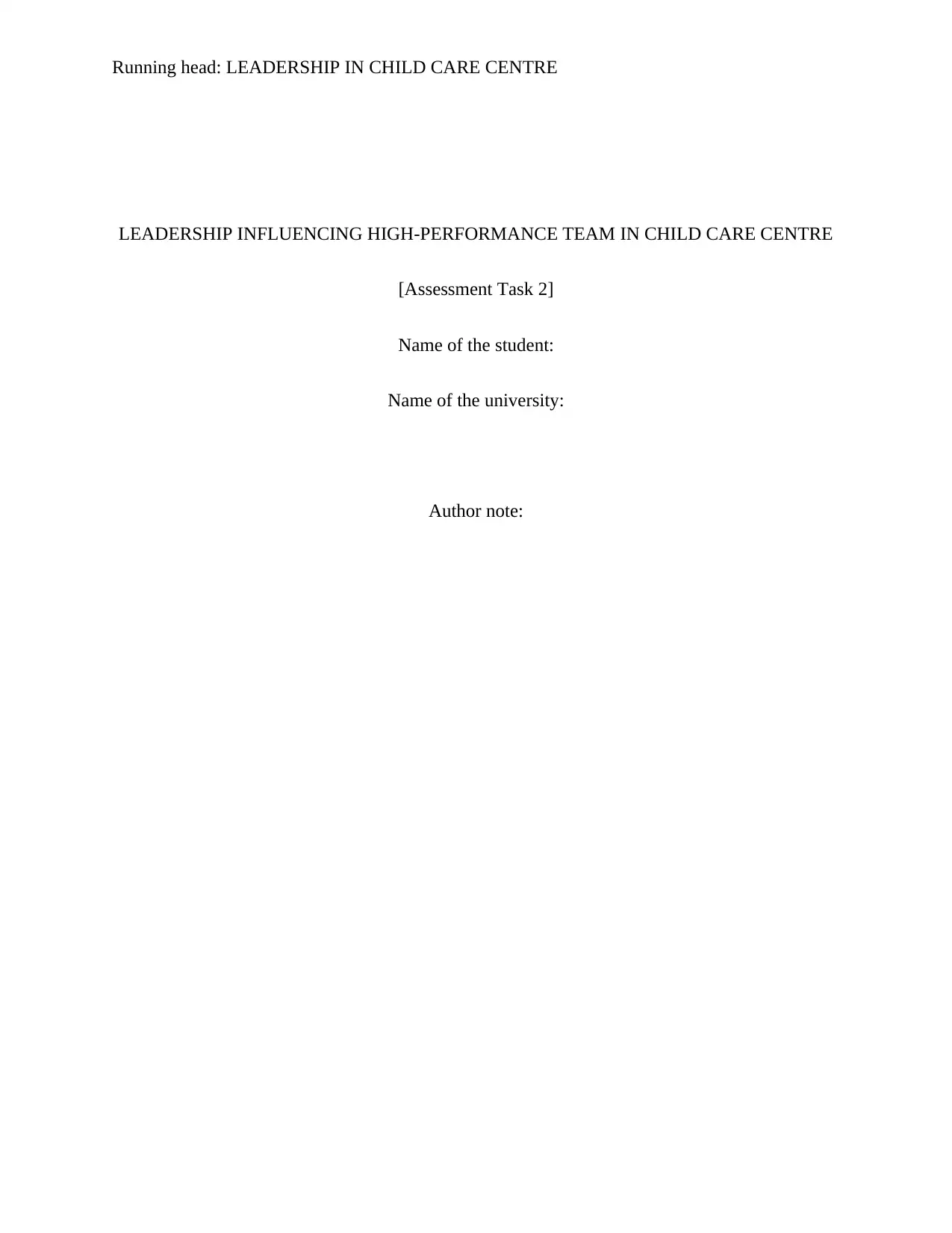
Running head: LEADERSHIP IN CHILD CARE CENTRE
LEADERSHIP INFLUENCING HIGH-PERFORMANCE TEAM IN CHILD CARE CENTRE
[Assessment Task 2]
Name of the student:
Name of the university:
Author note:
LEADERSHIP INFLUENCING HIGH-PERFORMANCE TEAM IN CHILD CARE CENTRE
[Assessment Task 2]
Name of the student:
Name of the university:
Author note:
Paraphrase This Document
Need a fresh take? Get an instant paraphrase of this document with our AI Paraphraser
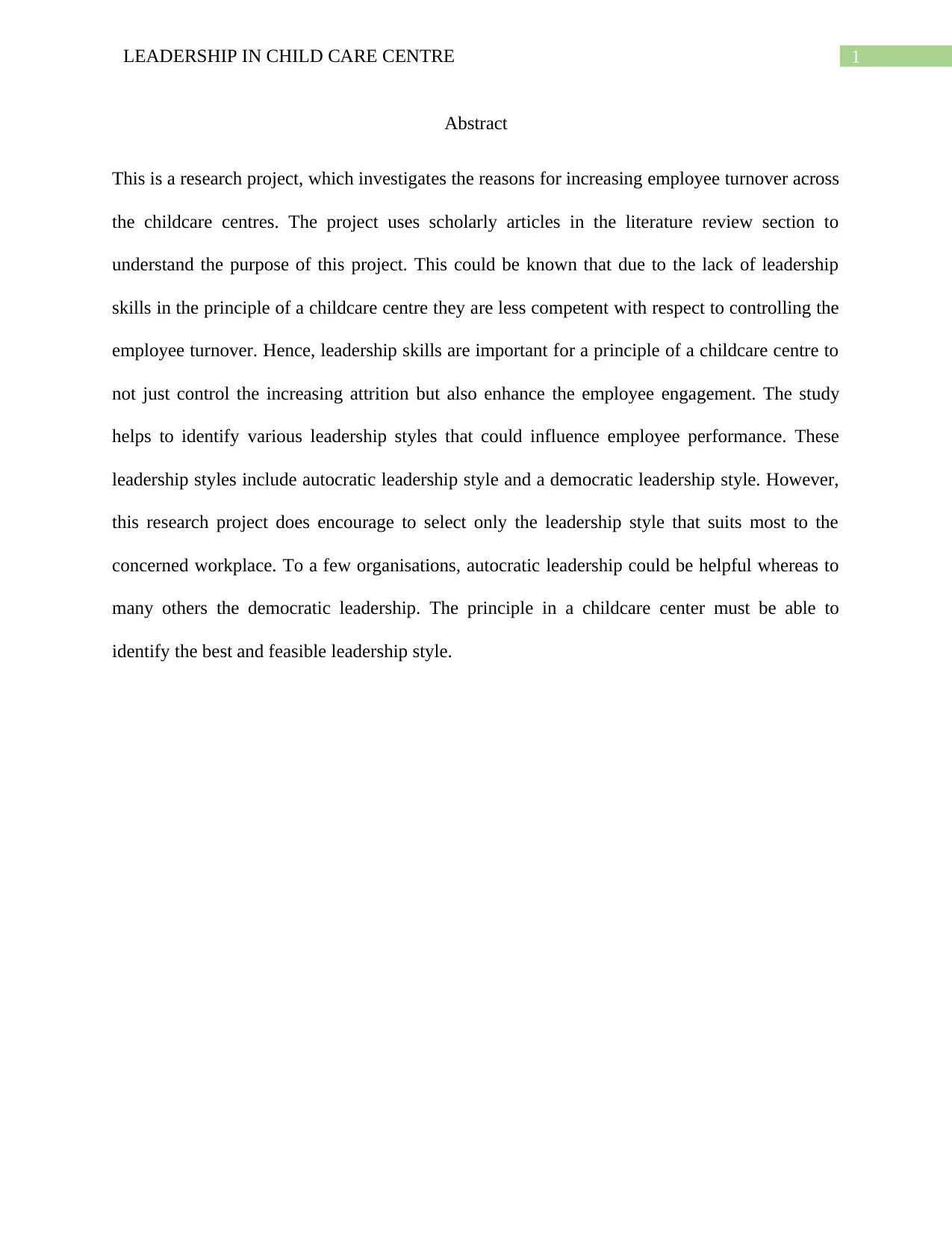
1LEADERSHIP IN CHILD CARE CENTRE
Abstract
This is a research project, which investigates the reasons for increasing employee turnover across
the childcare centres. The project uses scholarly articles in the literature review section to
understand the purpose of this project. This could be known that due to the lack of leadership
skills in the principle of a childcare centre they are less competent with respect to controlling the
employee turnover. Hence, leadership skills are important for a principle of a childcare centre to
not just control the increasing attrition but also enhance the employee engagement. The study
helps to identify various leadership styles that could influence employee performance. These
leadership styles include autocratic leadership style and a democratic leadership style. However,
this research project does encourage to select only the leadership style that suits most to the
concerned workplace. To a few organisations, autocratic leadership could be helpful whereas to
many others the democratic leadership. The principle in a childcare center must be able to
identify the best and feasible leadership style.
Abstract
This is a research project, which investigates the reasons for increasing employee turnover across
the childcare centres. The project uses scholarly articles in the literature review section to
understand the purpose of this project. This could be known that due to the lack of leadership
skills in the principle of a childcare centre they are less competent with respect to controlling the
employee turnover. Hence, leadership skills are important for a principle of a childcare centre to
not just control the increasing attrition but also enhance the employee engagement. The study
helps to identify various leadership styles that could influence employee performance. These
leadership styles include autocratic leadership style and a democratic leadership style. However,
this research project does encourage to select only the leadership style that suits most to the
concerned workplace. To a few organisations, autocratic leadership could be helpful whereas to
many others the democratic leadership. The principle in a childcare center must be able to
identify the best and feasible leadership style.
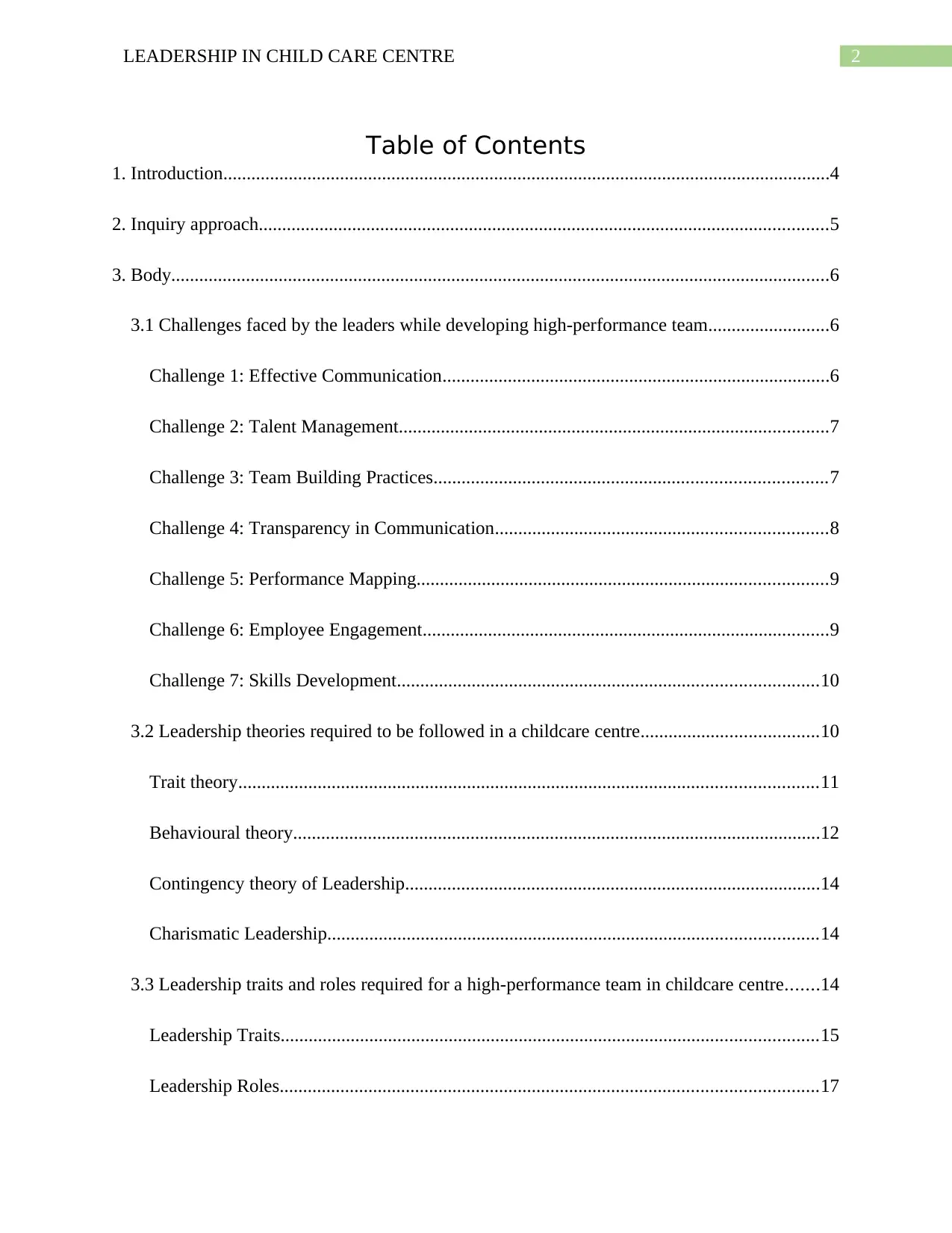
2LEADERSHIP IN CHILD CARE CENTRE
Table of Contents
1. Introduction..................................................................................................................................4
2. Inquiry approach..........................................................................................................................5
3. Body.............................................................................................................................................6
3.1 Challenges faced by the leaders while developing high-performance team..........................6
Challenge 1: Effective Communication...................................................................................6
Challenge 2: Talent Management............................................................................................7
Challenge 3: Team Building Practices....................................................................................7
Challenge 4: Transparency in Communication.......................................................................8
Challenge 5: Performance Mapping........................................................................................9
Challenge 6: Employee Engagement.......................................................................................9
Challenge 7: Skills Development..........................................................................................10
3.2 Leadership theories required to be followed in a childcare centre......................................10
Trait theory............................................................................................................................11
Behavioural theory.................................................................................................................12
Contingency theory of Leadership.........................................................................................14
Charismatic Leadership.........................................................................................................14
3.3 Leadership traits and roles required for a high-performance team in childcare centre.......14
Leadership Traits...................................................................................................................15
Leadership Roles...................................................................................................................17
Table of Contents
1. Introduction..................................................................................................................................4
2. Inquiry approach..........................................................................................................................5
3. Body.............................................................................................................................................6
3.1 Challenges faced by the leaders while developing high-performance team..........................6
Challenge 1: Effective Communication...................................................................................6
Challenge 2: Talent Management............................................................................................7
Challenge 3: Team Building Practices....................................................................................7
Challenge 4: Transparency in Communication.......................................................................8
Challenge 5: Performance Mapping........................................................................................9
Challenge 6: Employee Engagement.......................................................................................9
Challenge 7: Skills Development..........................................................................................10
3.2 Leadership theories required to be followed in a childcare centre......................................10
Trait theory............................................................................................................................11
Behavioural theory.................................................................................................................12
Contingency theory of Leadership.........................................................................................14
Charismatic Leadership.........................................................................................................14
3.3 Leadership traits and roles required for a high-performance team in childcare centre.......14
Leadership Traits...................................................................................................................15
Leadership Roles...................................................................................................................17
⊘ This is a preview!⊘
Do you want full access?
Subscribe today to unlock all pages.

Trusted by 1+ million students worldwide

3LEADERSHIP IN CHILD CARE CENTRE
4. Conclusion.................................................................................................................................18
References......................................................................................................................................21
4. Conclusion.................................................................................................................................18
References......................................................................................................................................21
Paraphrase This Document
Need a fresh take? Get an instant paraphrase of this document with our AI Paraphraser
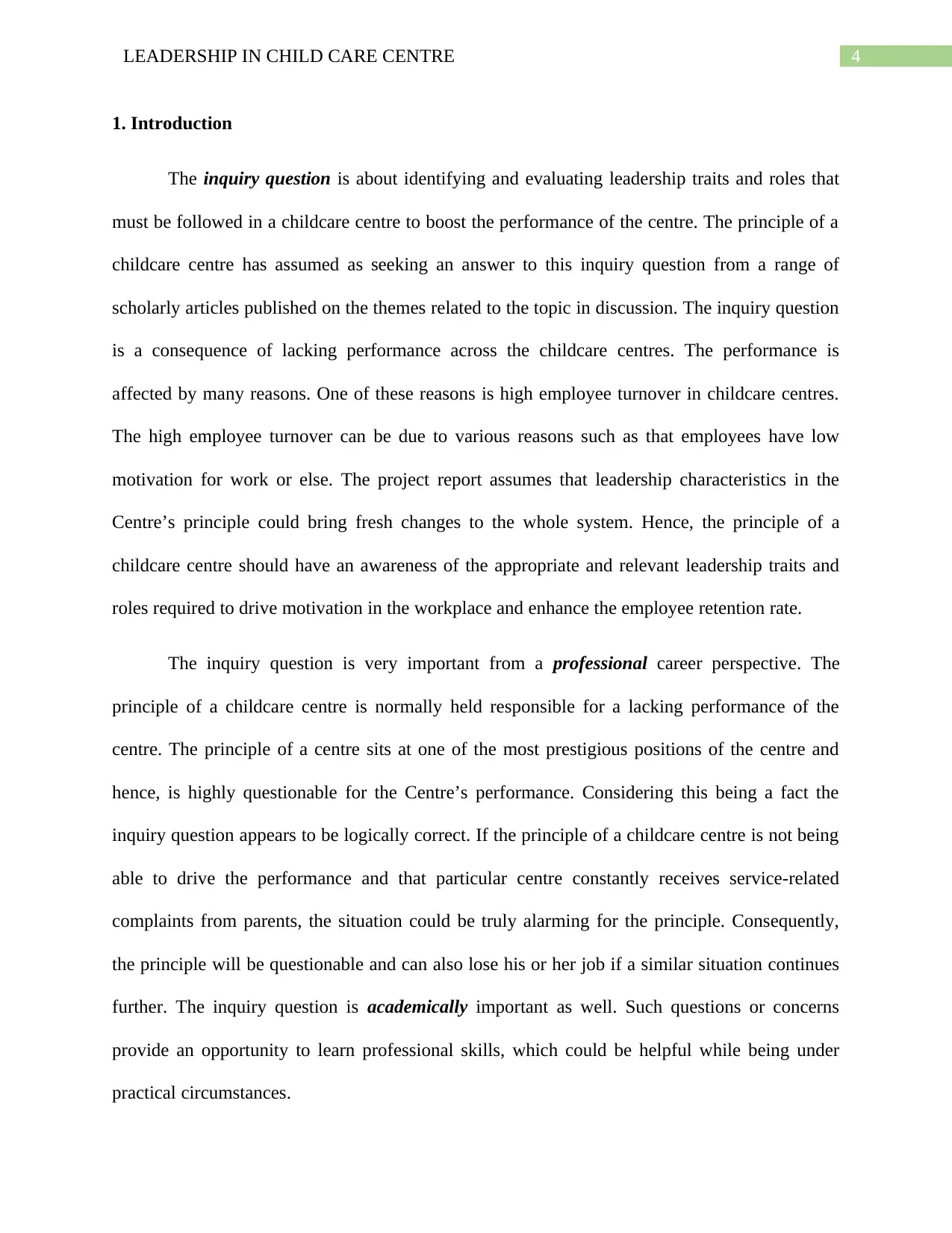
4LEADERSHIP IN CHILD CARE CENTRE
1. Introduction
The inquiry question is about identifying and evaluating leadership traits and roles that
must be followed in a childcare centre to boost the performance of the centre. The principle of a
childcare centre has assumed as seeking an answer to this inquiry question from a range of
scholarly articles published on the themes related to the topic in discussion. The inquiry question
is a consequence of lacking performance across the childcare centres. The performance is
affected by many reasons. One of these reasons is high employee turnover in childcare centres.
The high employee turnover can be due to various reasons such as that employees have low
motivation for work or else. The project report assumes that leadership characteristics in the
Centre’s principle could bring fresh changes to the whole system. Hence, the principle of a
childcare centre should have an awareness of the appropriate and relevant leadership traits and
roles required to drive motivation in the workplace and enhance the employee retention rate.
The inquiry question is very important from a professional career perspective. The
principle of a childcare centre is normally held responsible for a lacking performance of the
centre. The principle of a centre sits at one of the most prestigious positions of the centre and
hence, is highly questionable for the Centre’s performance. Considering this being a fact the
inquiry question appears to be logically correct. If the principle of a childcare centre is not being
able to drive the performance and that particular centre constantly receives service-related
complaints from parents, the situation could be truly alarming for the principle. Consequently,
the principle will be questionable and can also lose his or her job if a similar situation continues
further. The inquiry question is academically important as well. Such questions or concerns
provide an opportunity to learn professional skills, which could be helpful while being under
practical circumstances.
1. Introduction
The inquiry question is about identifying and evaluating leadership traits and roles that
must be followed in a childcare centre to boost the performance of the centre. The principle of a
childcare centre has assumed as seeking an answer to this inquiry question from a range of
scholarly articles published on the themes related to the topic in discussion. The inquiry question
is a consequence of lacking performance across the childcare centres. The performance is
affected by many reasons. One of these reasons is high employee turnover in childcare centres.
The high employee turnover can be due to various reasons such as that employees have low
motivation for work or else. The project report assumes that leadership characteristics in the
Centre’s principle could bring fresh changes to the whole system. Hence, the principle of a
childcare centre should have an awareness of the appropriate and relevant leadership traits and
roles required to drive motivation in the workplace and enhance the employee retention rate.
The inquiry question is very important from a professional career perspective. The
principle of a childcare centre is normally held responsible for a lacking performance of the
centre. The principle of a centre sits at one of the most prestigious positions of the centre and
hence, is highly questionable for the Centre’s performance. Considering this being a fact the
inquiry question appears to be logically correct. If the principle of a childcare centre is not being
able to drive the performance and that particular centre constantly receives service-related
complaints from parents, the situation could be truly alarming for the principle. Consequently,
the principle will be questionable and can also lose his or her job if a similar situation continues
further. The inquiry question is academically important as well. Such questions or concerns
provide an opportunity to learn professional skills, which could be helpful while being under
practical circumstances.
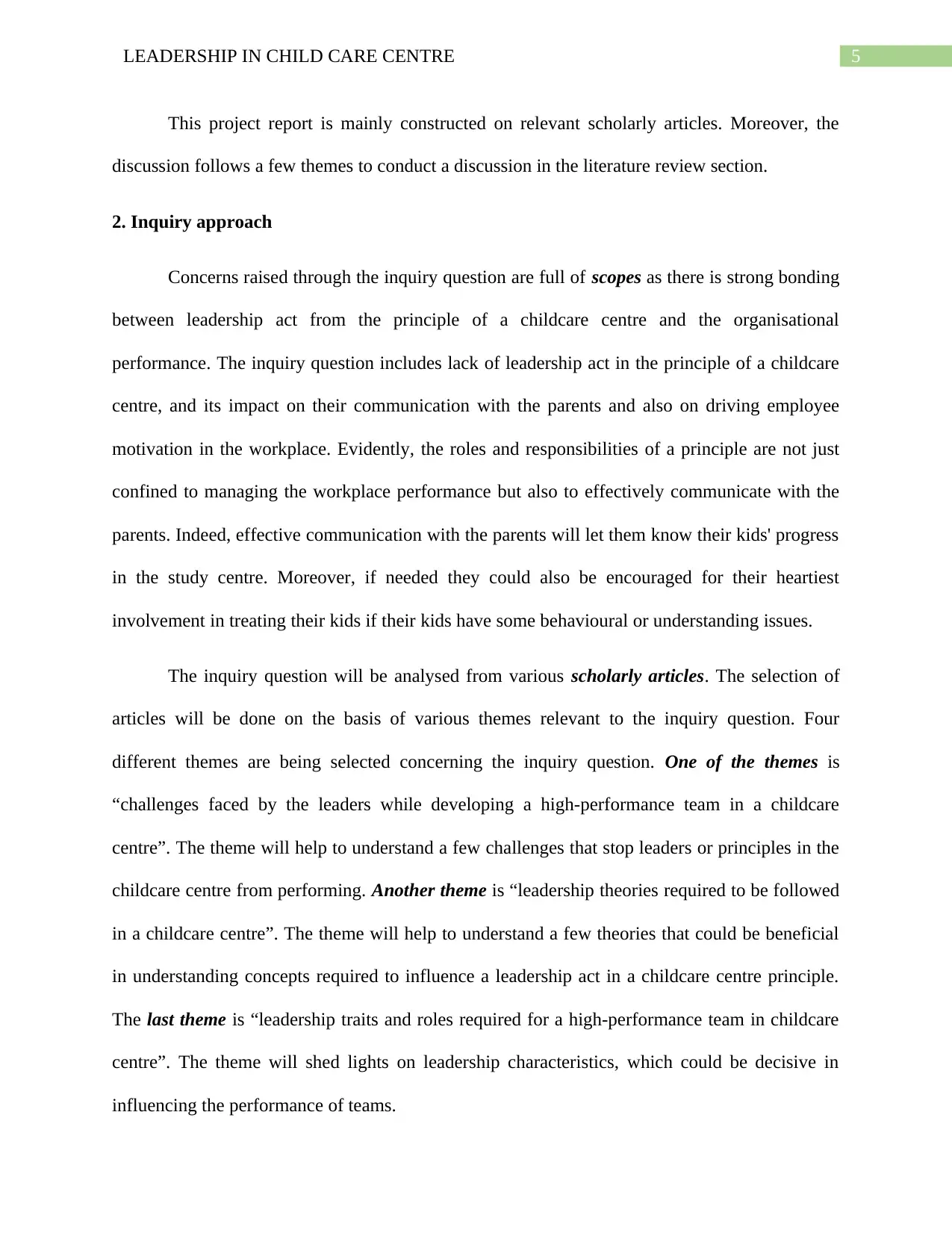
5LEADERSHIP IN CHILD CARE CENTRE
This project report is mainly constructed on relevant scholarly articles. Moreover, the
discussion follows a few themes to conduct a discussion in the literature review section.
2. Inquiry approach
Concerns raised through the inquiry question are full of scopes as there is strong bonding
between leadership act from the principle of a childcare centre and the organisational
performance. The inquiry question includes lack of leadership act in the principle of a childcare
centre, and its impact on their communication with the parents and also on driving employee
motivation in the workplace. Evidently, the roles and responsibilities of a principle are not just
confined to managing the workplace performance but also to effectively communicate with the
parents. Indeed, effective communication with the parents will let them know their kids' progress
in the study centre. Moreover, if needed they could also be encouraged for their heartiest
involvement in treating their kids if their kids have some behavioural or understanding issues.
The inquiry question will be analysed from various scholarly articles. The selection of
articles will be done on the basis of various themes relevant to the inquiry question. Four
different themes are being selected concerning the inquiry question. One of the themes is
“challenges faced by the leaders while developing a high-performance team in a childcare
centre”. The theme will help to understand a few challenges that stop leaders or principles in the
childcare centre from performing. Another theme is “leadership theories required to be followed
in a childcare centre”. The theme will help to understand a few theories that could be beneficial
in understanding concepts required to influence a leadership act in a childcare centre principle.
The last theme is “leadership traits and roles required for a high-performance team in childcare
centre”. The theme will shed lights on leadership characteristics, which could be decisive in
influencing the performance of teams.
This project report is mainly constructed on relevant scholarly articles. Moreover, the
discussion follows a few themes to conduct a discussion in the literature review section.
2. Inquiry approach
Concerns raised through the inquiry question are full of scopes as there is strong bonding
between leadership act from the principle of a childcare centre and the organisational
performance. The inquiry question includes lack of leadership act in the principle of a childcare
centre, and its impact on their communication with the parents and also on driving employee
motivation in the workplace. Evidently, the roles and responsibilities of a principle are not just
confined to managing the workplace performance but also to effectively communicate with the
parents. Indeed, effective communication with the parents will let them know their kids' progress
in the study centre. Moreover, if needed they could also be encouraged for their heartiest
involvement in treating their kids if their kids have some behavioural or understanding issues.
The inquiry question will be analysed from various scholarly articles. The selection of
articles will be done on the basis of various themes relevant to the inquiry question. Four
different themes are being selected concerning the inquiry question. One of the themes is
“challenges faced by the leaders while developing a high-performance team in a childcare
centre”. The theme will help to understand a few challenges that stop leaders or principles in the
childcare centre from performing. Another theme is “leadership theories required to be followed
in a childcare centre”. The theme will help to understand a few theories that could be beneficial
in understanding concepts required to influence a leadership act in a childcare centre principle.
The last theme is “leadership traits and roles required for a high-performance team in childcare
centre”. The theme will shed lights on leadership characteristics, which could be decisive in
influencing the performance of teams.
⊘ This is a preview!⊘
Do you want full access?
Subscribe today to unlock all pages.

Trusted by 1+ million students worldwide
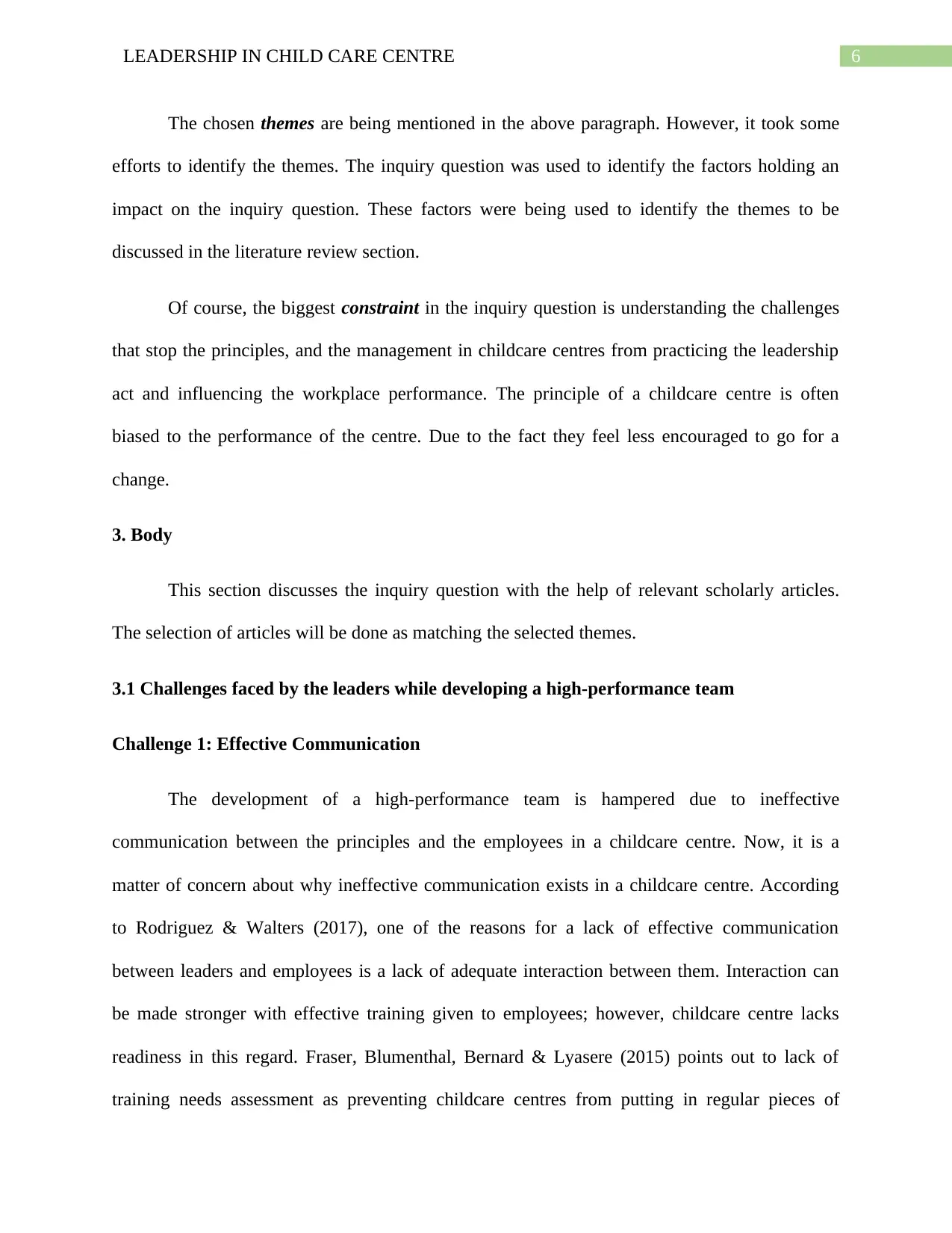
6LEADERSHIP IN CHILD CARE CENTRE
The chosen themes are being mentioned in the above paragraph. However, it took some
efforts to identify the themes. The inquiry question was used to identify the factors holding an
impact on the inquiry question. These factors were being used to identify the themes to be
discussed in the literature review section.
Of course, the biggest constraint in the inquiry question is understanding the challenges
that stop the principles, and the management in childcare centres from practicing the leadership
act and influencing the workplace performance. The principle of a childcare centre is often
biased to the performance of the centre. Due to the fact they feel less encouraged to go for a
change.
3. Body
This section discusses the inquiry question with the help of relevant scholarly articles.
The selection of articles will be done as matching the selected themes.
3.1 Challenges faced by the leaders while developing a high-performance team
Challenge 1: Effective Communication
The development of a high-performance team is hampered due to ineffective
communication between the principles and the employees in a childcare centre. Now, it is a
matter of concern about why ineffective communication exists in a childcare centre. According
to Rodriguez & Walters (2017), one of the reasons for a lack of effective communication
between leaders and employees is a lack of adequate interaction between them. Interaction can
be made stronger with effective training given to employees; however, childcare centre lacks
readiness in this regard. Fraser, Blumenthal, Bernard & Lyasere (2015) points out to lack of
training needs assessment as preventing childcare centres from putting in regular pieces of
The chosen themes are being mentioned in the above paragraph. However, it took some
efforts to identify the themes. The inquiry question was used to identify the factors holding an
impact on the inquiry question. These factors were being used to identify the themes to be
discussed in the literature review section.
Of course, the biggest constraint in the inquiry question is understanding the challenges
that stop the principles, and the management in childcare centres from practicing the leadership
act and influencing the workplace performance. The principle of a childcare centre is often
biased to the performance of the centre. Due to the fact they feel less encouraged to go for a
change.
3. Body
This section discusses the inquiry question with the help of relevant scholarly articles.
The selection of articles will be done as matching the selected themes.
3.1 Challenges faced by the leaders while developing a high-performance team
Challenge 1: Effective Communication
The development of a high-performance team is hampered due to ineffective
communication between the principles and the employees in a childcare centre. Now, it is a
matter of concern about why ineffective communication exists in a childcare centre. According
to Rodriguez & Walters (2017), one of the reasons for a lack of effective communication
between leaders and employees is a lack of adequate interaction between them. Interaction can
be made stronger with effective training given to employees; however, childcare centre lacks
readiness in this regard. Fraser, Blumenthal, Bernard & Lyasere (2015) points out to lack of
training needs assessment as preventing childcare centres from putting in regular pieces of
Paraphrase This Document
Need a fresh take? Get an instant paraphrase of this document with our AI Paraphraser
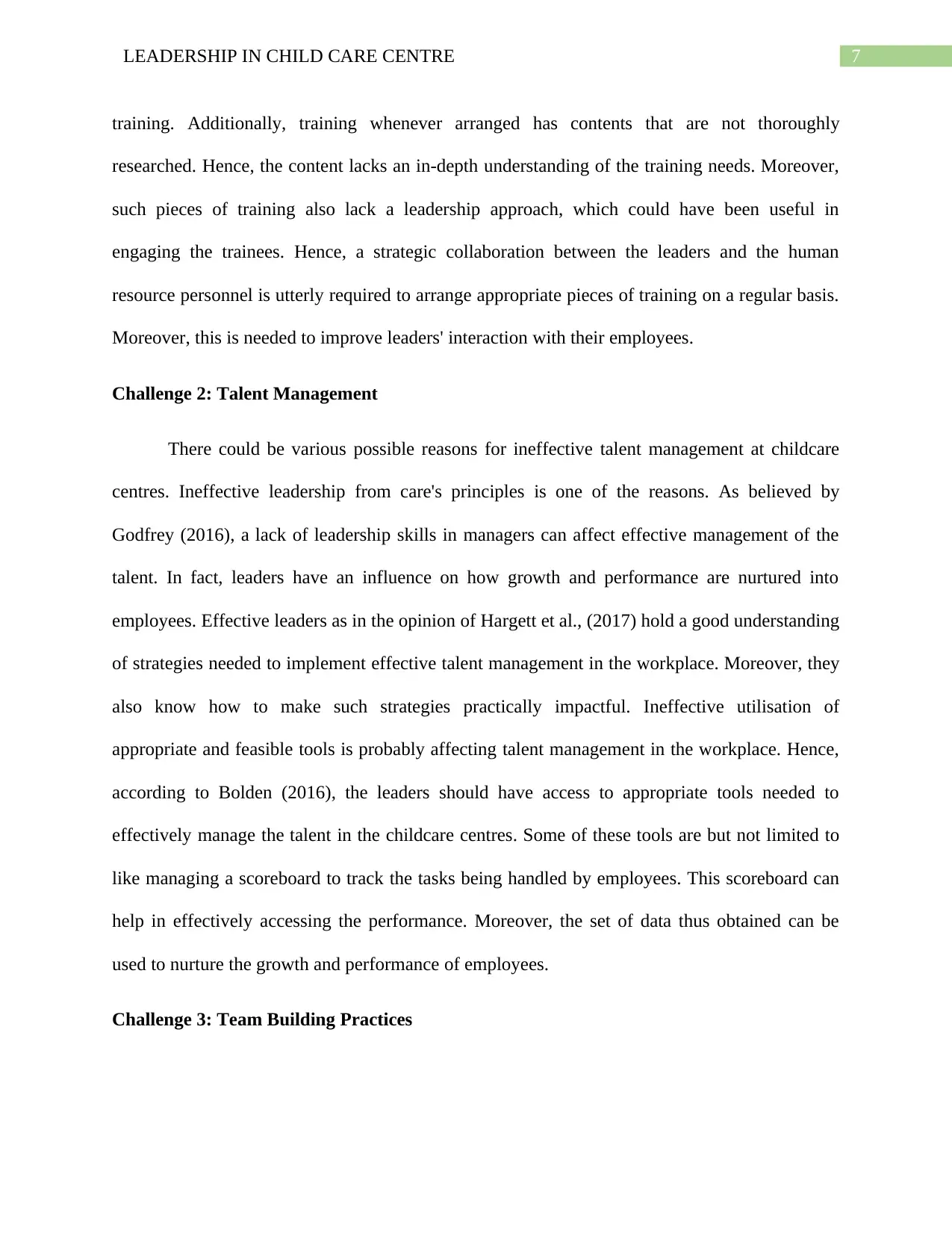
7LEADERSHIP IN CHILD CARE CENTRE
training. Additionally, training whenever arranged has contents that are not thoroughly
researched. Hence, the content lacks an in-depth understanding of the training needs. Moreover,
such pieces of training also lack a leadership approach, which could have been useful in
engaging the trainees. Hence, a strategic collaboration between the leaders and the human
resource personnel is utterly required to arrange appropriate pieces of training on a regular basis.
Moreover, this is needed to improve leaders' interaction with their employees.
Challenge 2: Talent Management
There could be various possible reasons for ineffective talent management at childcare
centres. Ineffective leadership from care's principles is one of the reasons. As believed by
Godfrey (2016), a lack of leadership skills in managers can affect effective management of the
talent. In fact, leaders have an influence on how growth and performance are nurtured into
employees. Effective leaders as in the opinion of Hargett et al., (2017) hold a good understanding
of strategies needed to implement effective talent management in the workplace. Moreover, they
also know how to make such strategies practically impactful. Ineffective utilisation of
appropriate and feasible tools is probably affecting talent management in the workplace. Hence,
according to Bolden (2016), the leaders should have access to appropriate tools needed to
effectively manage the talent in the childcare centres. Some of these tools are but not limited to
like managing a scoreboard to track the tasks being handled by employees. This scoreboard can
help in effectively accessing the performance. Moreover, the set of data thus obtained can be
used to nurture the growth and performance of employees.
Challenge 3: Team Building Practices
training. Additionally, training whenever arranged has contents that are not thoroughly
researched. Hence, the content lacks an in-depth understanding of the training needs. Moreover,
such pieces of training also lack a leadership approach, which could have been useful in
engaging the trainees. Hence, a strategic collaboration between the leaders and the human
resource personnel is utterly required to arrange appropriate pieces of training on a regular basis.
Moreover, this is needed to improve leaders' interaction with their employees.
Challenge 2: Talent Management
There could be various possible reasons for ineffective talent management at childcare
centres. Ineffective leadership from care's principles is one of the reasons. As believed by
Godfrey (2016), a lack of leadership skills in managers can affect effective management of the
talent. In fact, leaders have an influence on how growth and performance are nurtured into
employees. Effective leaders as in the opinion of Hargett et al., (2017) hold a good understanding
of strategies needed to implement effective talent management in the workplace. Moreover, they
also know how to make such strategies practically impactful. Ineffective utilisation of
appropriate and feasible tools is probably affecting talent management in the workplace. Hence,
according to Bolden (2016), the leaders should have access to appropriate tools needed to
effectively manage the talent in the childcare centres. Some of these tools are but not limited to
like managing a scoreboard to track the tasks being handled by employees. This scoreboard can
help in effectively accessing the performance. Moreover, the set of data thus obtained can be
used to nurture the growth and performance of employees.
Challenge 3: Team Building Practices
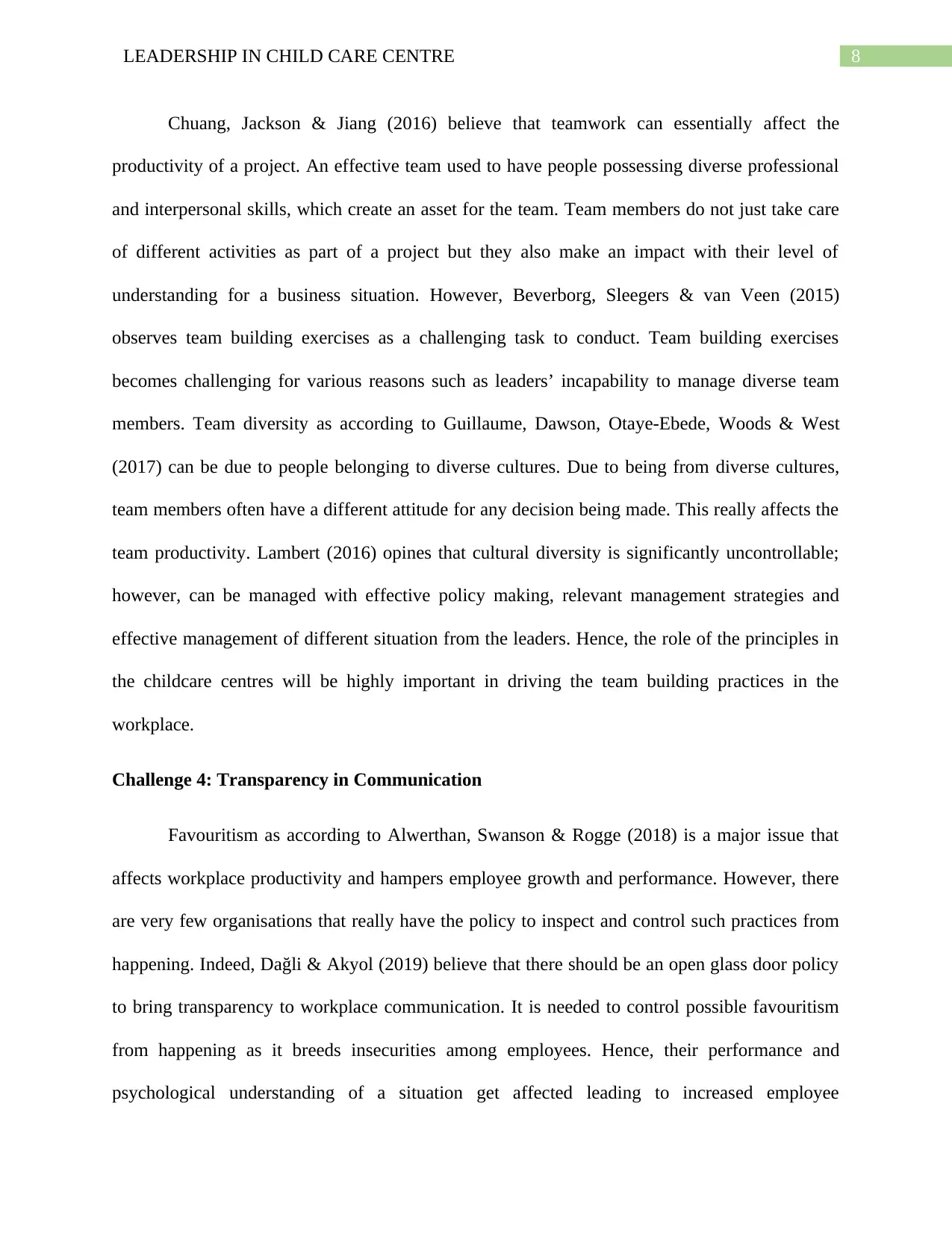
8LEADERSHIP IN CHILD CARE CENTRE
Chuang, Jackson & Jiang (2016) believe that teamwork can essentially affect the
productivity of a project. An effective team used to have people possessing diverse professional
and interpersonal skills, which create an asset for the team. Team members do not just take care
of different activities as part of a project but they also make an impact with their level of
understanding for a business situation. However, Beverborg, Sleegers & van Veen (2015)
observes team building exercises as a challenging task to conduct. Team building exercises
becomes challenging for various reasons such as leaders’ incapability to manage diverse team
members. Team diversity as according to Guillaume, Dawson, Otaye‐Ebede, Woods & West
(2017) can be due to people belonging to diverse cultures. Due to being from diverse cultures,
team members often have a different attitude for any decision being made. This really affects the
team productivity. Lambert (2016) opines that cultural diversity is significantly uncontrollable;
however, can be managed with effective policy making, relevant management strategies and
effective management of different situation from the leaders. Hence, the role of the principles in
the childcare centres will be highly important in driving the team building practices in the
workplace.
Challenge 4: Transparency in Communication
Favouritism as according to Alwerthan, Swanson & Rogge (2018) is a major issue that
affects workplace productivity and hampers employee growth and performance. However, there
are very few organisations that really have the policy to inspect and control such practices from
happening. Indeed, Dağli & Akyol (2019) believe that there should be an open glass door policy
to bring transparency to workplace communication. It is needed to control possible favouritism
from happening as it breeds insecurities among employees. Hence, their performance and
psychological understanding of a situation get affected leading to increased employee
Chuang, Jackson & Jiang (2016) believe that teamwork can essentially affect the
productivity of a project. An effective team used to have people possessing diverse professional
and interpersonal skills, which create an asset for the team. Team members do not just take care
of different activities as part of a project but they also make an impact with their level of
understanding for a business situation. However, Beverborg, Sleegers & van Veen (2015)
observes team building exercises as a challenging task to conduct. Team building exercises
becomes challenging for various reasons such as leaders’ incapability to manage diverse team
members. Team diversity as according to Guillaume, Dawson, Otaye‐Ebede, Woods & West
(2017) can be due to people belonging to diverse cultures. Due to being from diverse cultures,
team members often have a different attitude for any decision being made. This really affects the
team productivity. Lambert (2016) opines that cultural diversity is significantly uncontrollable;
however, can be managed with effective policy making, relevant management strategies and
effective management of different situation from the leaders. Hence, the role of the principles in
the childcare centres will be highly important in driving the team building practices in the
workplace.
Challenge 4: Transparency in Communication
Favouritism as according to Alwerthan, Swanson & Rogge (2018) is a major issue that
affects workplace productivity and hampers employee growth and performance. However, there
are very few organisations that really have the policy to inspect and control such practices from
happening. Indeed, Dağli & Akyol (2019) believe that there should be an open glass door policy
to bring transparency to workplace communication. It is needed to control possible favouritism
from happening as it breeds insecurities among employees. Hence, their performance and
psychological understanding of a situation get affected leading to increased employee
⊘ This is a preview!⊘
Do you want full access?
Subscribe today to unlock all pages.

Trusted by 1+ million students worldwide
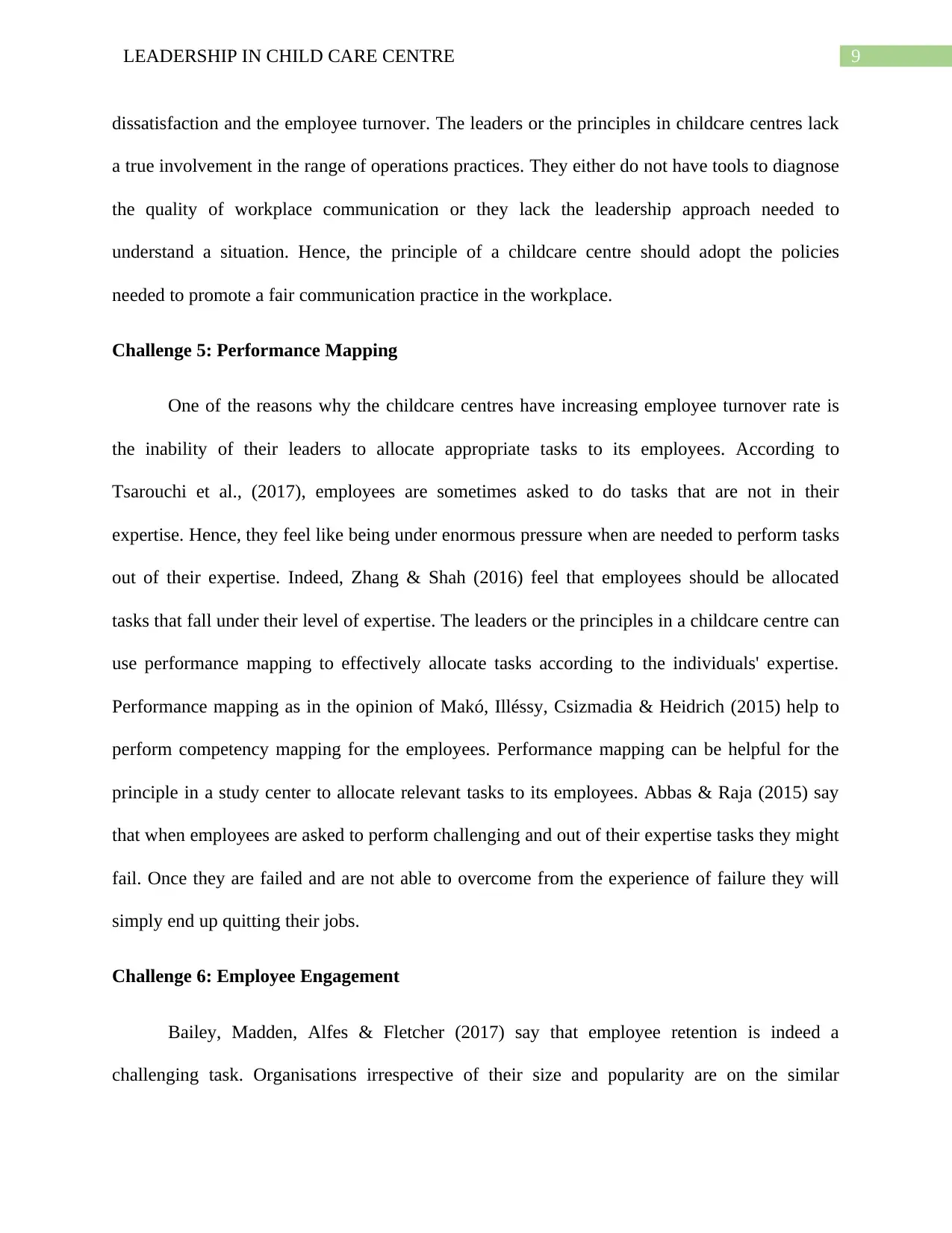
9LEADERSHIP IN CHILD CARE CENTRE
dissatisfaction and the employee turnover. The leaders or the principles in childcare centres lack
a true involvement in the range of operations practices. They either do not have tools to diagnose
the quality of workplace communication or they lack the leadership approach needed to
understand a situation. Hence, the principle of a childcare centre should adopt the policies
needed to promote a fair communication practice in the workplace.
Challenge 5: Performance Mapping
One of the reasons why the childcare centres have increasing employee turnover rate is
the inability of their leaders to allocate appropriate tasks to its employees. According to
Tsarouchi et al., (2017), employees are sometimes asked to do tasks that are not in their
expertise. Hence, they feel like being under enormous pressure when are needed to perform tasks
out of their expertise. Indeed, Zhang & Shah (2016) feel that employees should be allocated
tasks that fall under their level of expertise. The leaders or the principles in a childcare centre can
use performance mapping to effectively allocate tasks according to the individuals' expertise.
Performance mapping as in the opinion of Makó, Illéssy, Csizmadia & Heidrich (2015) help to
perform competency mapping for the employees. Performance mapping can be helpful for the
principle in a study center to allocate relevant tasks to its employees. Abbas & Raja (2015) say
that when employees are asked to perform challenging and out of their expertise tasks they might
fail. Once they are failed and are not able to overcome from the experience of failure they will
simply end up quitting their jobs.
Challenge 6: Employee Engagement
Bailey, Madden, Alfes & Fletcher (2017) say that employee retention is indeed a
challenging task. Organisations irrespective of their size and popularity are on the similar
dissatisfaction and the employee turnover. The leaders or the principles in childcare centres lack
a true involvement in the range of operations practices. They either do not have tools to diagnose
the quality of workplace communication or they lack the leadership approach needed to
understand a situation. Hence, the principle of a childcare centre should adopt the policies
needed to promote a fair communication practice in the workplace.
Challenge 5: Performance Mapping
One of the reasons why the childcare centres have increasing employee turnover rate is
the inability of their leaders to allocate appropriate tasks to its employees. According to
Tsarouchi et al., (2017), employees are sometimes asked to do tasks that are not in their
expertise. Hence, they feel like being under enormous pressure when are needed to perform tasks
out of their expertise. Indeed, Zhang & Shah (2016) feel that employees should be allocated
tasks that fall under their level of expertise. The leaders or the principles in a childcare centre can
use performance mapping to effectively allocate tasks according to the individuals' expertise.
Performance mapping as in the opinion of Makó, Illéssy, Csizmadia & Heidrich (2015) help to
perform competency mapping for the employees. Performance mapping can be helpful for the
principle in a study center to allocate relevant tasks to its employees. Abbas & Raja (2015) say
that when employees are asked to perform challenging and out of their expertise tasks they might
fail. Once they are failed and are not able to overcome from the experience of failure they will
simply end up quitting their jobs.
Challenge 6: Employee Engagement
Bailey, Madden, Alfes & Fletcher (2017) say that employee retention is indeed a
challenging task. Organisations irrespective of their size and popularity are on the similar
Paraphrase This Document
Need a fresh take? Get an instant paraphrase of this document with our AI Paraphraser
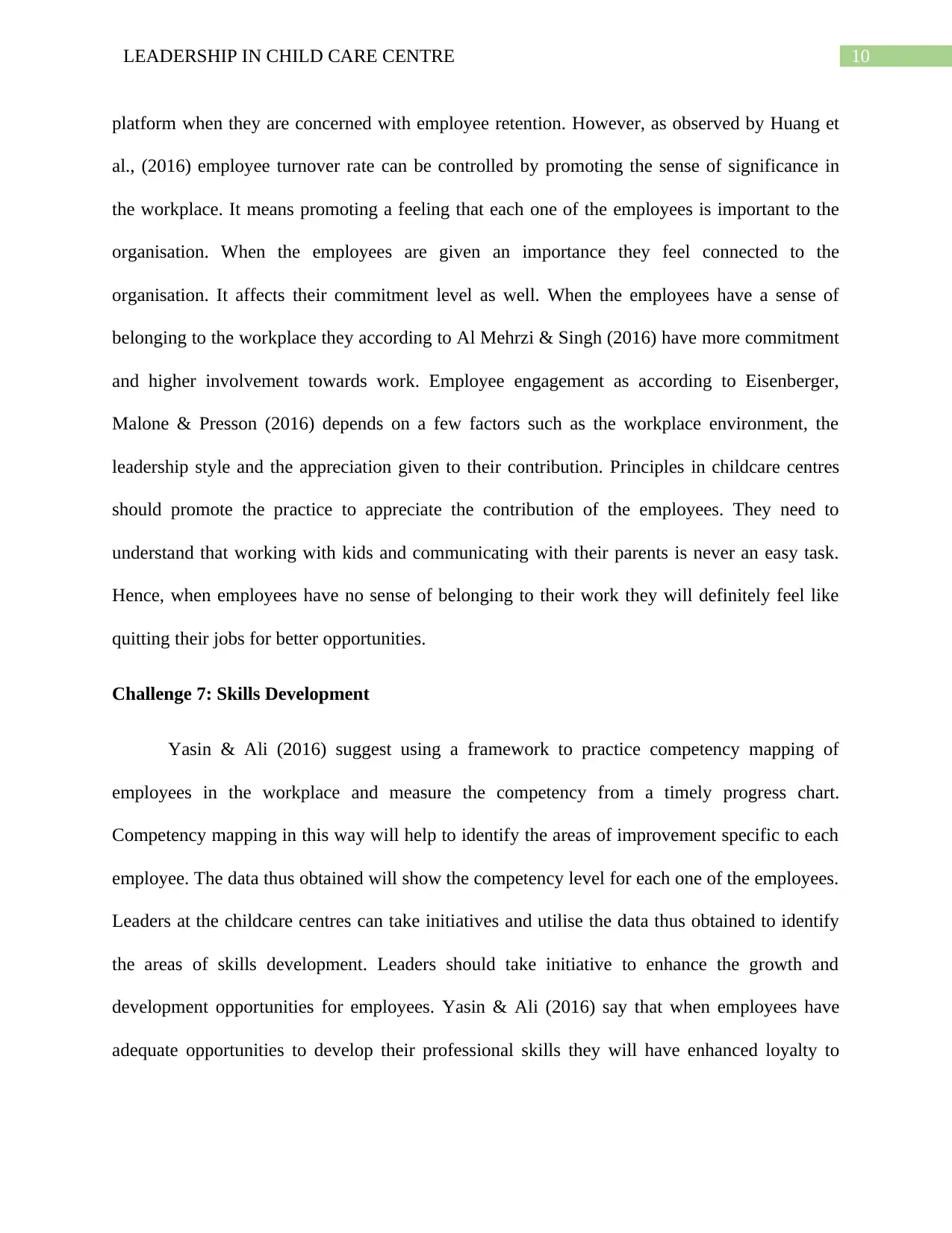
10LEADERSHIP IN CHILD CARE CENTRE
platform when they are concerned with employee retention. However, as observed by Huang et
al., (2016) employee turnover rate can be controlled by promoting the sense of significance in
the workplace. It means promoting a feeling that each one of the employees is important to the
organisation. When the employees are given an importance they feel connected to the
organisation. It affects their commitment level as well. When the employees have a sense of
belonging to the workplace they according to Al Mehrzi & Singh (2016) have more commitment
and higher involvement towards work. Employee engagement as according to Eisenberger,
Malone & Presson (2016) depends on a few factors such as the workplace environment, the
leadership style and the appreciation given to their contribution. Principles in childcare centres
should promote the practice to appreciate the contribution of the employees. They need to
understand that working with kids and communicating with their parents is never an easy task.
Hence, when employees have no sense of belonging to their work they will definitely feel like
quitting their jobs for better opportunities.
Challenge 7: Skills Development
Yasin & Ali (2016) suggest using a framework to practice competency mapping of
employees in the workplace and measure the competency from a timely progress chart.
Competency mapping in this way will help to identify the areas of improvement specific to each
employee. The data thus obtained will show the competency level for each one of the employees.
Leaders at the childcare centres can take initiatives and utilise the data thus obtained to identify
the areas of skills development. Leaders should take initiative to enhance the growth and
development opportunities for employees. Yasin & Ali (2016) say that when employees have
adequate opportunities to develop their professional skills they will have enhanced loyalty to
platform when they are concerned with employee retention. However, as observed by Huang et
al., (2016) employee turnover rate can be controlled by promoting the sense of significance in
the workplace. It means promoting a feeling that each one of the employees is important to the
organisation. When the employees are given an importance they feel connected to the
organisation. It affects their commitment level as well. When the employees have a sense of
belonging to the workplace they according to Al Mehrzi & Singh (2016) have more commitment
and higher involvement towards work. Employee engagement as according to Eisenberger,
Malone & Presson (2016) depends on a few factors such as the workplace environment, the
leadership style and the appreciation given to their contribution. Principles in childcare centres
should promote the practice to appreciate the contribution of the employees. They need to
understand that working with kids and communicating with their parents is never an easy task.
Hence, when employees have no sense of belonging to their work they will definitely feel like
quitting their jobs for better opportunities.
Challenge 7: Skills Development
Yasin & Ali (2016) suggest using a framework to practice competency mapping of
employees in the workplace and measure the competency from a timely progress chart.
Competency mapping in this way will help to identify the areas of improvement specific to each
employee. The data thus obtained will show the competency level for each one of the employees.
Leaders at the childcare centres can take initiatives and utilise the data thus obtained to identify
the areas of skills development. Leaders should take initiative to enhance the growth and
development opportunities for employees. Yasin & Ali (2016) say that when employees have
adequate opportunities to develop their professional skills they will have enhanced loyalty to
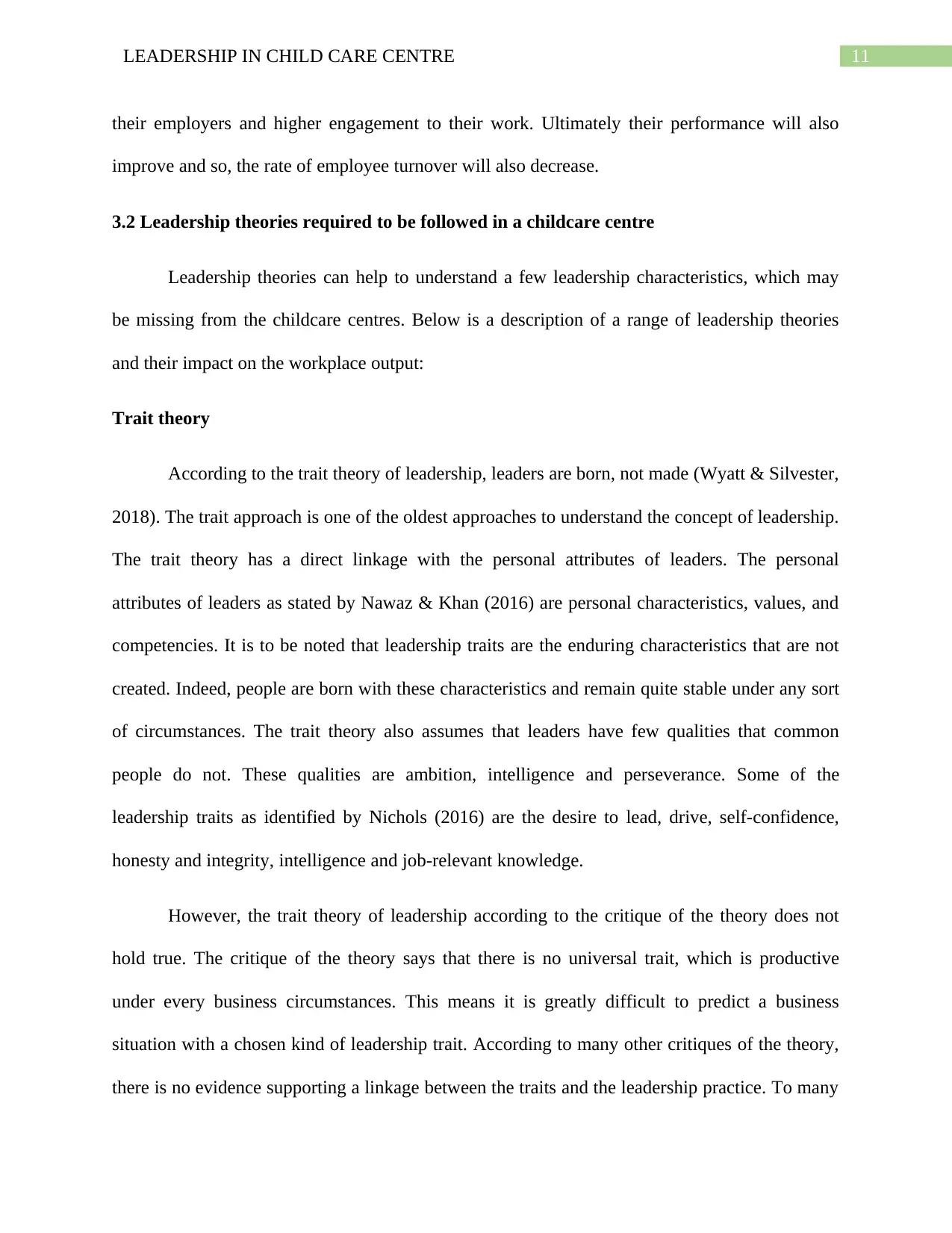
11LEADERSHIP IN CHILD CARE CENTRE
their employers and higher engagement to their work. Ultimately their performance will also
improve and so, the rate of employee turnover will also decrease.
3.2 Leadership theories required to be followed in a childcare centre
Leadership theories can help to understand a few leadership characteristics, which may
be missing from the childcare centres. Below is a description of a range of leadership theories
and their impact on the workplace output:
Trait theory
According to the trait theory of leadership, leaders are born, not made (Wyatt & Silvester,
2018). The trait approach is one of the oldest approaches to understand the concept of leadership.
The trait theory has a direct linkage with the personal attributes of leaders. The personal
attributes of leaders as stated by Nawaz & Khan (2016) are personal characteristics, values, and
competencies. It is to be noted that leadership traits are the enduring characteristics that are not
created. Indeed, people are born with these characteristics and remain quite stable under any sort
of circumstances. The trait theory also assumes that leaders have few qualities that common
people do not. These qualities are ambition, intelligence and perseverance. Some of the
leadership traits as identified by Nichols (2016) are the desire to lead, drive, self-confidence,
honesty and integrity, intelligence and job-relevant knowledge.
However, the trait theory of leadership according to the critique of the theory does not
hold true. The critique of the theory says that there is no universal trait, which is productive
under every business circumstances. This means it is greatly difficult to predict a business
situation with a chosen kind of leadership trait. According to many other critiques of the theory,
there is no evidence supporting a linkage between the traits and the leadership practice. To many
their employers and higher engagement to their work. Ultimately their performance will also
improve and so, the rate of employee turnover will also decrease.
3.2 Leadership theories required to be followed in a childcare centre
Leadership theories can help to understand a few leadership characteristics, which may
be missing from the childcare centres. Below is a description of a range of leadership theories
and their impact on the workplace output:
Trait theory
According to the trait theory of leadership, leaders are born, not made (Wyatt & Silvester,
2018). The trait approach is one of the oldest approaches to understand the concept of leadership.
The trait theory has a direct linkage with the personal attributes of leaders. The personal
attributes of leaders as stated by Nawaz & Khan (2016) are personal characteristics, values, and
competencies. It is to be noted that leadership traits are the enduring characteristics that are not
created. Indeed, people are born with these characteristics and remain quite stable under any sort
of circumstances. The trait theory also assumes that leaders have few qualities that common
people do not. These qualities are ambition, intelligence and perseverance. Some of the
leadership traits as identified by Nichols (2016) are the desire to lead, drive, self-confidence,
honesty and integrity, intelligence and job-relevant knowledge.
However, the trait theory of leadership according to the critique of the theory does not
hold true. The critique of the theory says that there is no universal trait, which is productive
under every business circumstances. This means it is greatly difficult to predict a business
situation with a chosen kind of leadership trait. According to many other critiques of the theory,
there is no evidence supporting a linkage between the traits and the leadership practice. To many
⊘ This is a preview!⊘
Do you want full access?
Subscribe today to unlock all pages.

Trusted by 1+ million students worldwide
1 out of 28
Related Documents
Your All-in-One AI-Powered Toolkit for Academic Success.
+13062052269
info@desklib.com
Available 24*7 on WhatsApp / Email
![[object Object]](/_next/static/media/star-bottom.7253800d.svg)
Unlock your academic potential
Copyright © 2020–2025 A2Z Services. All Rights Reserved. Developed and managed by ZUCOL.





